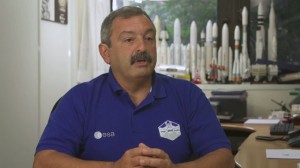ATV-5 mission manager Massimo Cislaghi sent this yesterday evening to the entire ATV team and agreed to share it with us here in the blog.
Whoever might have dared say that ATVs were not perfectly designed has witnessed another proof to the contrary. Some may know that an ATV is qualified for six months of orbital life. Performing beyond that threshold could be considered as unnecessary over-design. So perfectly in line with that time, six months and five days after ATV-5’s 29 July launch, Georges Lemaître experienced its first significant failure, on 3 February, when one of its four power chains suddenly stopped working.
The ATV Control Centre and Airbus Flight Segment teams calmly took the necessary counter-measures to stabilise vehicle conditions, and then troubleshoot and correct the problem. After thorough investigations, it was concluded that the problem originated from something occurring at the level of the interface of our Power Central Distribution Unit 4 and its battery that provides energy to that chain, when neither the Solar Array nor the Space Station can, such as during an eclipse when ATV is in free flight or simply when Space Station power is disconnected for whatever reason. From this conclusion two consequences were derived:
- A positive one, confirming that ATV-5 would be able to complete its attached phase until 14 February without any concern, as long as the Station power was available to feed our chain 4, thus restoring the nominal failure tolerance conditions, and
- A negative one, indicating that in case of any second failure during free flight, when daylight is not available, ATV would go into survival mode, which is not a nice situation since, in principle, it would prevent a controlled reentry
At this point our reliability experts started calculating the ATV-5 unreliability over the 13 days that were planned between undocking and the 27 February shallow reentry, and the resulting figure was unfortunately three times higher than was approved before the mission started.
Some discussions started about moving the undocking date as close as possible to the reentry date to reduce the free-flight unreliability, but this was quickly found to be impossible due to the Progress docking planned on 17 February, and there was insufficient time for negotiating with our Russian friends for a second postponement (it had already been postponed from 2 to 17 February on the Space Station Programme’s request, to favour the ATV shallow reentry experiment).
On the other hand advancing the shallow reentry date was also impossible due to the need to burn almost one tonne of ATV-5 propellant that was unused during the attached phase, which would have generated unacceptable explosion effects during reentry itself.
Therefore, to the great regret of all of us having worked on that shallow reentry experiment for some 18 months, be it in Toulouse, Les Mureaux, ESTEC, ESOC, Houston or across the scientific pool of around 80 (!) organisations throughout the world, on 10 February we were obliged to announce the sad breaking news: “The shallow reentry has been cancelled.” Therefore, all that I had written in my previous report “can be forgotten.”
There is no routine
The rest is routine (even if the routine does not exist in our business!): at the time of writing these lines, the ATV and Space Station hatches have already been closed, tomorrow afternoon ATV will separate from the Space Station (it is quite ironical that it is by coincidence the day of St.Valentine – the Saint of my Italian home town – for a separation!) and on Sunday evening, ATV-5 will perform its final dive half-way between New Zealand and Chile, like its four predecessors have quietly done in the past years.
And then after 20 years or so will come the time of the celebrations, commemorations, memories, pride, sadness, and so on… and last but not least searching for a new job for many of us, including the myself!
Thanks to all of you for all what you have done for this unique programme.


 Automated Transfer Vehicle page
Automated Transfer Vehicle page ATV blog archive
ATV blog archive
Discussion: no comments